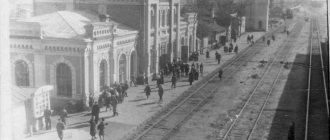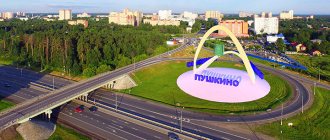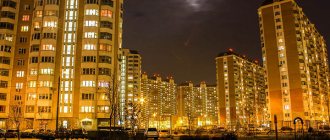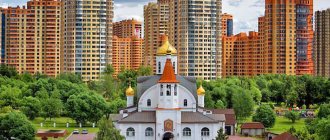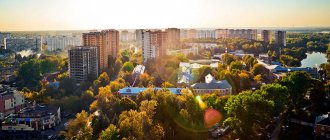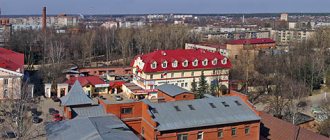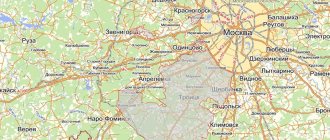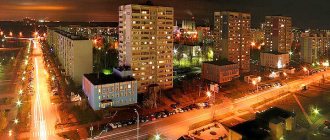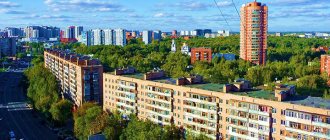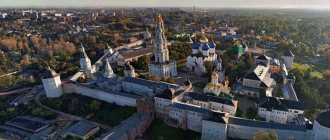For other places with the same name, see Golitsyno.
City in Moscow region, Russia
| Golitsyno Golitsyno | |
| City [1] | |
| Flag Coat of arms | |
| Location of Golitsyno | |
| Golitsyno Location of Golitsyno Show map of Russia Golitsyno Golitsyno (Moscow region) Show map of the Moscow region | |
| Coordinates: 55°36′53″N 36°59′14″E / 55.61472°N W. 36.98722°E / 55.61472; 36.98722 Coordinates: 55°36′53″N 36°59′14″E / 55.61472°N W. 36.98722°E / 55.61472; 36.98722 | |
| A country | Russia |
| Federal subject | Moscow region [1] |
| Administrative region | Odintsovo district [1] |
| Town | Golitsyno [1] |
| Based | 1872 |
| City status from | 2004 |
| Height | 180 m (590 ft) |
| population size (2010 Census) [2] | |
| • General | 17 593 |
| • Evaluate (2018) [3] | 17 651 ( + 0,3% ) |
| Administrative status | |
| • Capital from | Golitsyno [1] |
| Municipal status | |
| • Municipal district | Odintsovo municipal district [4] |
| • Urban village | Urban settlement Golitsyno [4] |
| • Capital from | Urban settlement Golitsyno [4] |
| Timezone | UTC+3 (MSK[5]) |
| Postal code [6] | 143040, 143041, 143043, 143044 |
| OKTMO ID | 46641104001 |
| Web site | golitsyno-gorod .ru |
Golitsyno
(Russian: Golitsyno) is a city in Odintsovo District in Moscow Oblast, Russia, located 40 km (25 mi) west of Moscow. Population: 17,593 (2010 census); [2] 16,189 (2002 census); [7] 23,315 (1989 census). [8]
Links[edit]
Notes[edit]
- ^ abcdef Resolution No. 123-PG
- ^ a b Federal State Statistics Service (2011). “All-Russian Population Census 2010. Volume 1" [All-Russian Population Census 2010, vol. 1]. All-Russian Population Census 2010 [All-Russian Population Census 2010]
. Federal State Statistics Service. - "26. The size of the permanent population of the Russian Federation by municipalities as of January 1, 2021". Federal State Statistics Service. Retrieved January 23, 2021.
- ^ abcd Law No. 64/2005-OZ
- "On the Calculation of Time". Official Internet portal of legal information
. June 3, 2011. Retrieved January 19, 2021. - Post office. Information and computing center of OASU RPO. ( Post office
).
Search for postal service objects ( postal Search for objects
) (in Russian) - ↑
Federal State Statistics Service of Russia (May 21, 2004).
“The population of Russia, the constituent entities of the Russian Federation as part of federal districts, urban settlements, settlements, settlements of 3 thousand or more people” [Population of Russia, its federal districts, federal districts, districts, urban settlements, rural settlements - administrative centers and rural settlements with a population of more than 3,000 people] (XLS). All-Russian Population Census 2002
. - “All-Union Population Census of 1989. The current population of union and autonomous republics, autonomous regions and districts, territories, negative phenomena, urban settlements and rural district centers” [All-Union Population Census of 1989: current population of union and autonomous republics, Autonomous regions and districts , territories, regions, districts, towns and villages performing the functions of district administrative centers. All-Union Population Census of 1989 [All-Union Population Census of 1989]
.
Institute of Demography of the National Research University: Higher School of Economics [Institute of Demography of the National Research University: Higher School of Economics]. 1989 - via Demoscope Weekly
.
Sources [edit]
- Governor of the Moscow region. Resolution No. 123-PG of September 28, 2010 “On registration data of administrative-territorial and territorial units of the Moscow region,” as amended. Resolution No. 252-PG dated June 26, 2015 “On introducing changes to the registration data of administrative-territorial and territorial units of the Moscow region.” Published: “Information Bulletin of the Moscow Region”, No. 10, October 30, 2010 (Governor of the Moscow Region. Resolution No. 123-PG dated September 28, 2010 “ On the inventory of administrative-territorial units of the Moscow Region”
as amended by Resolution No. 252-PG dated June 26, 2015 “
On amendments to the inventory count”).
Data from administrative-territorial units of the Moscow region .). - Moscow Regional Duma. Law No. 64 / 2005-OZ of February 28, 2005 “On the status and boundaries of the Odintsovo municipal district and newly formed municipalities within it,” as amended. Law No. 7 / 2012-OZ of February 17, 2012 “On amendments to the Law of the Moscow Region “On the status and boundaries of the Odintsovo municipal district and newly formed municipalities within it””. Came into force on the date of official publication. Published: “Daily News. Moscow Region", No. 42, March 10, 2005 (Moscow Regional Duma. Law of February 28, 2005 No. 64/2005-OZ “ On the status and boundaries of the Odintsovo municipal district and
its constituent
municipalities”
as amended by the Law dated February 17, No. 7/2012-OZ., 2012.
On amendments to the Law of the Moscow Region “On the status and boundaries of the Odintsovo municipal district and the newly formed municipalities within it
.” Valid from the date of official publication.).
Golitsyno
Golitsyno before the 1917 revolution
The first mention of Golitsyno dates back to 1870. A small settlement arose during the construction of the Moscow-Smolensk-Brest railway line. The new branch was supposed to bring enormous benefits to the Russian Empire, as it connected it with Europe. The Golitsyno railway station was built at forty-first verst from Moscow. The station received its name thanks to the princely family of Golitsyn. Their estate was located not far from the place where the station was built. The station consisted of only a small two-story wooden building. Not far from the building there was a station village where the station workers lived. It was from this village that the future city began its history.
In the 1890s, a basket weaving workshop was established at the station. The peasants who lived in the surrounding settlements have been engaged in this trade for more than one generation. However, in order to survive in the competition, it was necessary to work several times faster, which inevitably led to a deterioration in the quality of manufactured products. In order to preserve the craft and give peasants the opportunity to earn money, the Moscow Zemstvo opened a workshop at the Golitsyno station, in which handicraftsmen were taught how to properly conduct business. In addition to basket weaving, the workshop taught furniture making.
The lands on which the Golitsyno station was located belonged to Dmitry Borisovich Golitsyn at the beginning of the twentieth century. Most of this land was occupied by forest. Dmitry Borisovich decided that keeping the land under the forest was impractical and unprofitable. The forest was cut down, and the land was sold off in plots for the construction of country houses. The dacha settlement that appeared on Golitsyn land at the beginning of the twentieth century consisted of thirteen driveways, avenues and highways, the names of which either indicated the direction (the Petrovskoye highway led to the village of Petrovskoye, for example), or corresponded to the names of members of the family of Prince Dmitry Borisovich (Ekaterininsky, Borisovsky and Dmitrievsky prospects). The village arose south of Golitsyno station.
From 1906 to 1910, many new buildings were built in the village. A new stone station was built, a new platform, a gymnasium, pedestrian and road bridges, and Abyssinian wells appeared. The streets were lit with gas lamps. Golitsyn widely advertised his “town”, despite the fact that it was built extremely slowly. The main reason for the slow construction was the high price of land. It was possible to buy such a plot for cash or in installments. The station's freight turnover increased significantly by 1912. Mainly bricks and firewood were transported along this branch. At the beginning of the twentieth century, the need for bricks was especially great. The growth of industry and the emergence of new enterprises required more and more building materials. At first, prices on the railway were favorable for Russian industrialists. A brick production plant appeared in Golitsyn. The owner of the enterprise was the merchant Maksimov. The bricks at the enterprise were made by hand. The abundance of cheap labor made it possible to produce building materials without the use of machines.
After the revolution
In 1917, the political system changed in the country. At the end of the year, a village council was created, headed by Pyotr Volkov. During the Civil War, the third regimental division was formed at the station under the leadership of the brothers V. and N. Kuibyshev. The division acted against the troops of Wrangel and Denikin. After the revolution, the private gymnasium in Golitsyno became a labor school and was transferred to the department of education of the People's Commissariat of Railways. The school was named the Golitsyn Railway School. For a long time this school was the only cultural institution in the village. In addition to it, a city council and a hospital were built in Golitsyno. In the 30s, Golitsyno became a favorite place for the work of Soviet writers. In 1932, the creative house of the Writers' Union appeared here (the former mansion of F. Korsh). Over the years, many famous Soviet writers rested in this house. It was here that the famous Soviet teacher Anton Makarenko spent the last years of his life. In 1939, Makarenko died suddenly on a train en route to Moscow.
At the end of the 40s, the Medic rest home was built in the village of Golitsyno, which was located in the Medsantruda department. In the early 60s, the Central Courses of the Central Council for the Management of Trade Union Resorts were organized on the basis of this holiday home. On the basis of the courses, in turn, the Educational and Methodological Center was created in the 80s. Currently, this center has been transformed into JSC “Educational and Methodical”. Currently, it is a unique country complex that combines a training center and a recreation center where corporate events are often held.
In the post-war years, Golitsyno turned into a large industrial settlement. At the end of the 40s, the station was reconstructed and the railway tracks were electrified. In the 50s, on the site of the Zvenigorodsky Labor fishing artel, founded in the late 20s, the Golitsyn Ceramic Plant was created. Over time, this plant became the largest supplier of clay bricks for the Moscow region and Moscow. A cultural and educational center appeared at the plant, uniting several creative teams. A library and club were also built. The Firefly hat factory appeared instead of an artel producing musical instruments, toys, brooches and buttons. The first multi-storey buildings were built in Golitsyno only in the 60s. The Keramikov and Rabochiy Poselok microdistricts appeared.
Institute of Border Troops
In the early 70s, the Higher Military-Political School of the Border Troops of the KGB of the USSR was built on the territory of Golitsyno. The military complex had everything necessary for the successful training of highly qualified border guard officers. The school traces its history back to the First School of Border Guard Troops of the OGPU, created in 1930 in the city of New Peterhof in the Leningrad Region. This was the first basic educational institution for the border guard. On its basis, many similar educational institutions were created in Kharkov, Saratov and Moscow. The school's first graduation took place in 1932. The school became a school only in 1937. In the first years of the Great Patriotic War, the school made 3 early graduations. More than two thousand officers were trained for the front. In 1942, the educational institution was evacuated to Saratov, where officer training continued until the end of the war.
In 1967, it was decided to move the school to Golitsyno. The construction of the educational institution building was completed in 1972. The school was named in honor of K. E. Voroshilov. The teaching staff was formed from employees of the Moscow and Alma-Ata border schools. Today the school is called the Golitsyn Institute of Border Troops of the FSB of Russia. This is one of the largest and most famous military higher educational institutions in the Russian Federation. The institute uses modern teaching technologies. There are 15 departments conducting educational activities here. In 1997–2001, girls could also study at the institute. In 2003, the educational institution was renamed and received the name “Golitsyn Border Institute of the Federal Security Service of the Russian Federation.”
City in the 21st century
On May 9, 1985, on the fortieth anniversary of the Victory over the Nazi invaders, a monument to the fallen defenders of the Motherland was unveiled. The monument was created with donations from village residents. Golitsyno became a city only at the beginning of the new millennium. On September 9, 2004, the village received its new status. In 2006, the reconstruction of Station Square was carried out. A shopping complex was built in front of the station building. In the northern part of Golitsyno, construction began on a new residential microdistrict called “Molodezhny”. At the beginning of the new millennium, a new general plan for the city was approved. First of all, the plan provides for the demolition of dilapidated housing, the construction of new buildings and an increase in the amount of living space per capita. The plan also includes the construction of a swimming pool, a hotel, a cinema and a cultural park. In the future, the city will increase the number of medical and children's institutions, enterprises, shops and libraries.
Composition of the urban settlement
| № | Locality | Type of settlement | Population |
| 1 | Butyn | village | ↗180[6] |
| 2 | Golitsyno | city, administrative center | ↗17 535[1] |
| 3 | Kobyakovo | village | ↘225[6] |
| 4 | Research Institute Radio | village | ↗237[6] |
| 5 | October | village | ↗5[6] |
| 6 | Sivkovo | village | ↗46[6] |
| 7 | Sidorovskoe | village | ↗125[6] |
Location advantages
Golitsyno, located on the Small Moscow Ring, is reached by two highways: Minskoye and Mozhaiskoye, and within the city there is a railway station of the same name, and it is separated from Moscow by exactly 40 km. Not too much to cause big difficulties getting to work and home, but quite enough to isolate yourself from city noise and concrete dust.
New buildings in Golitsyno are being built according to a master plan that provides for the construction of places for recreation (swimming pool, cultural park, cinema), education (kindergartens, schools, secondary specialized educational institutions), and provision of medical services.
